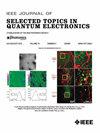On Error Rate Approximations for FSO Systems With Weak Turbulence and Pointing Errors
IF 5.1
2区 工程技术
Q1 ENGINEERING, ELECTRICAL & ELECTRONIC
IEEE Journal of Selected Topics in Quantum Electronics
Pub Date : 2025-07-17
DOI:10.1109/JSTQE.2025.3590410
引用次数: 0
Abstract
Atmospheric attenuation, atmospheric turbulence, geometric spread, and pointing errors, degrade the performance of free-space optical transmission. In the weak turbulence regime, the probability density function describing the distribution of the channel fading coefficient that models these four effects is known in the literature. This function is an integral equation, which makes it difficult to find simple analytical expressions of important performance metrics such as the bit error rate (BER) and symbol error rate (SER). In this paper, we present simple and accurate approximations of the average BER and SER for pulse-amplitude modulation (PAM) in the weak turbulence regime for an intensity modulation and direct detection system. Our numerical results show that the proposed expressions exhibit excellent accuracy when compared against Monte Carlo simulations. To demonstrate the usefulness of the developed approximations, we perform two asymptotic analyses. First, we investigate the additional transmit power required to maintain the same SER when the spectral efficiency increases by 1 b/symbol. Second, we study the asymptotic behavior of our SER approximation for dense PAM constellations and high transmit power.具有弱湍流和指向误差的FSO系统误差率逼近
大气衰减、大气湍流、几何扩散和指向误差等都会降低自由空间光传输的性能。在弱湍流状态下,文献中已知描述通道衰落系数分布的概率密度函数,该概率密度函数模拟了这四种效应。该函数是一个积分方程,因此很难找到诸如误码率(BER)和符号误码率(SER)等重要性能指标的简单解析表达式。在本文中,我们给出了一个强度调制和直接探测系统在弱湍流状态下脉冲幅度调制(PAM)的平均误码率和平均误码率的简单而精确的近似。我们的数值结果表明,与蒙特卡罗模拟相比,所提出的表达式具有优异的精度。为了证明所开发的近似的有效性,我们进行了两个渐近分析。首先,我们研究了当频谱效率每增加1 b/symbol时,保持相同SER所需的额外发射功率。其次,我们研究了密集PAM星座和高发射功率的SER近似的渐近行为。
本文章由计算机程序翻译,如有差异,请以英文原文为准。
求助全文
约1分钟内获得全文
求助全文
来源期刊

IEEE Journal of Selected Topics in Quantum Electronics
工程技术-工程:电子与电气
CiteScore
10.60
自引率
2.00%
发文量
212
审稿时长
3 months
期刊介绍:
Papers published in the IEEE Journal of Selected Topics in Quantum Electronics fall within the broad field of science and technology of quantum electronics of a device, subsystem, or system-oriented nature. Each issue is devoted to a specific topic within this broad spectrum. Announcements of the topical areas planned for future issues, along with deadlines for receipt of manuscripts, are published in this Journal and in the IEEE Journal of Quantum Electronics. Generally, the scope of manuscripts appropriate to this Journal is the same as that for the IEEE Journal of Quantum Electronics. Manuscripts are published that report original theoretical and/or experimental research results that advance the scientific and technological base of quantum electronics devices, systems, or applications. The Journal is dedicated toward publishing research results that advance the state of the art or add to the understanding of the generation, amplification, modulation, detection, waveguiding, or propagation characteristics of coherent electromagnetic radiation having sub-millimeter and shorter wavelengths. In order to be suitable for publication in this Journal, the content of manuscripts concerned with subject-related research must have a potential impact on advancing the technological base of quantum electronic devices, systems, and/or applications. Potential authors of subject-related research have the responsibility of pointing out this potential impact. System-oriented manuscripts must be concerned with systems that perform a function previously unavailable or that outperform previously established systems that did not use quantum electronic components or concepts. Tutorial and review papers are by invitation only.
 求助内容:
求助内容: 应助结果提醒方式:
应助结果提醒方式:


